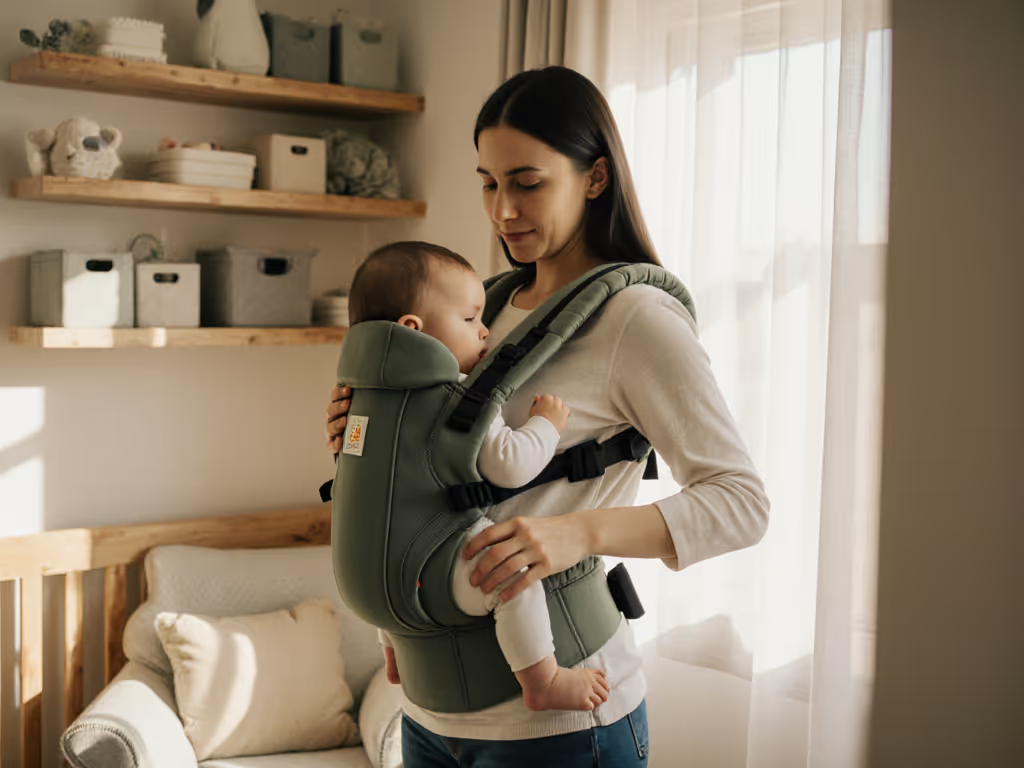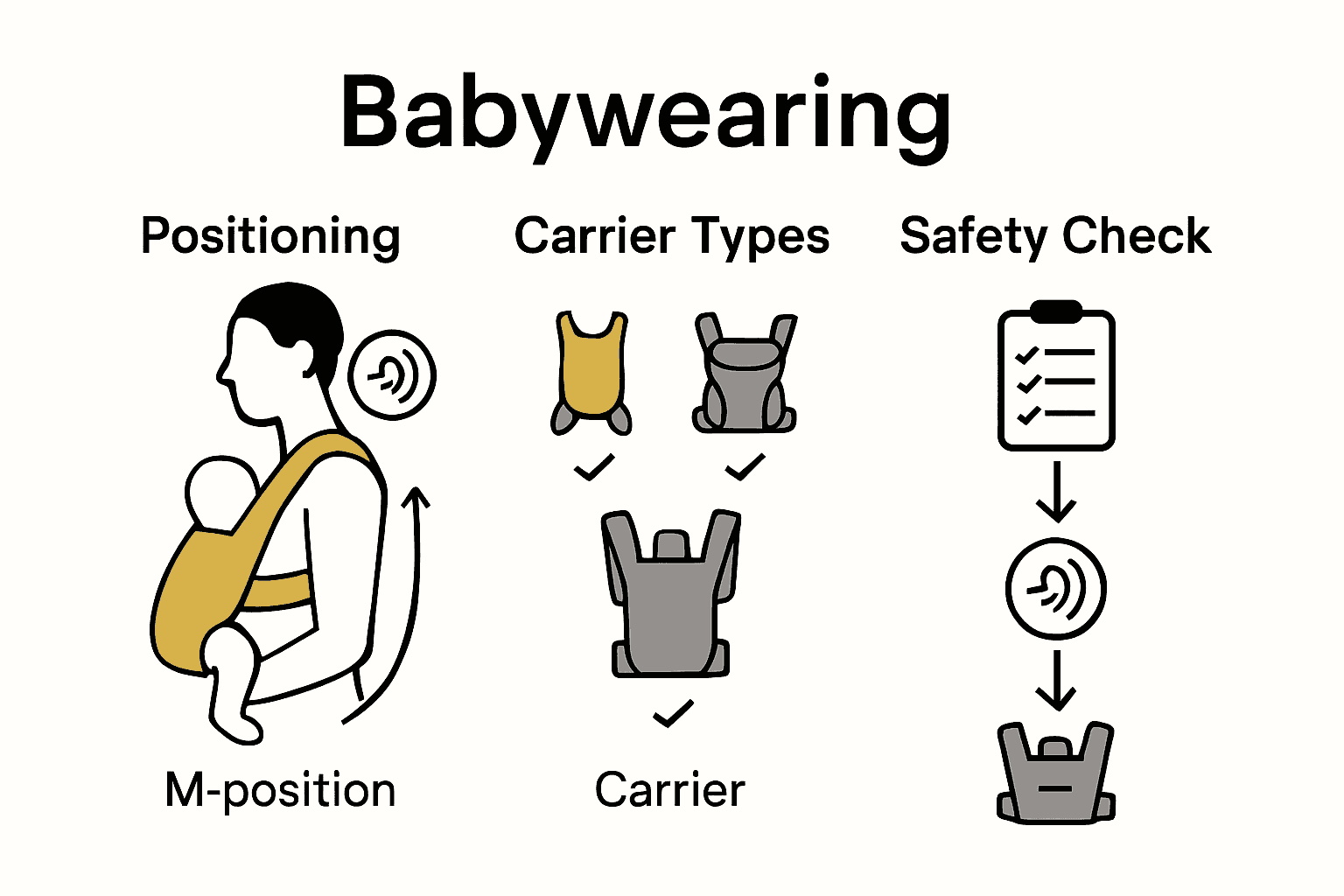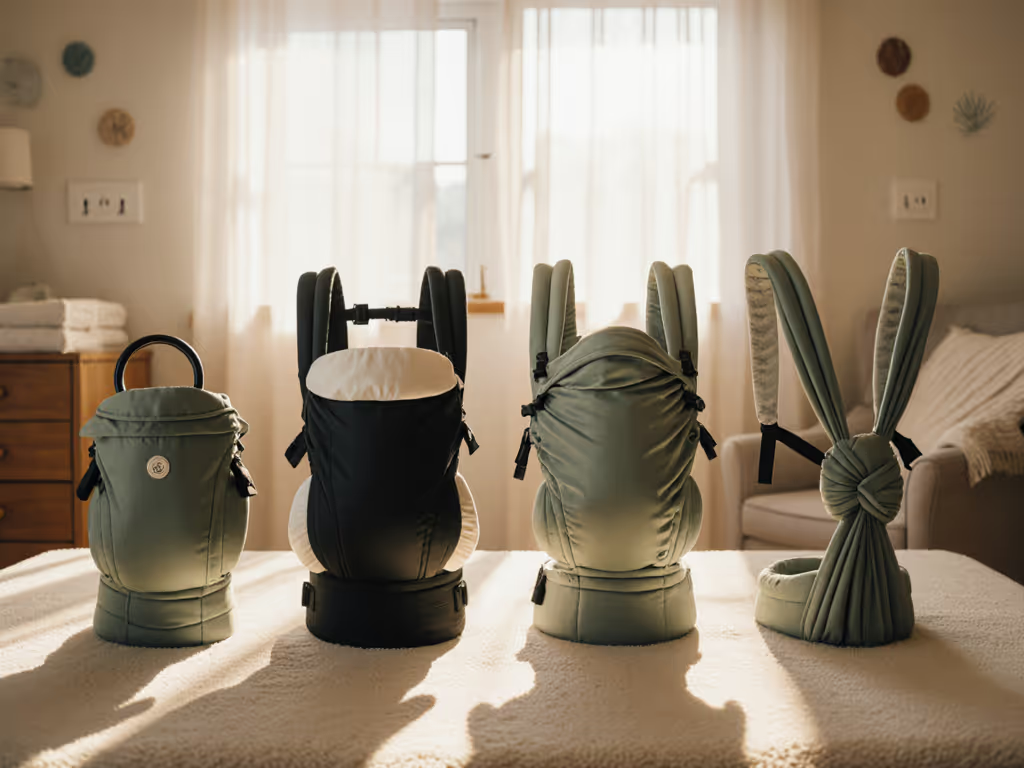
Complete Guide to Babywearing Safety Essentials

Over 80% of new parents say that babywearing helps them bond while tackling daily tasks. This age-old practice offers more than hands-free convenience—it has a direct impact on your baby’s physical growth and emotional security. Knowing the key safety principles and proper carrier use can make all the difference in preventing injuries and supporting healthy development. Get clear, practical guidance on making babywearing both safe and rewarding for you and your child.
Key Takeaways
| Point | Details |
|---|---|
| Safety First | Ensure your baby is positioned correctly to support spinal, airway, and hip health. Monitor their position and comfort regularly. |
| Choosing the Right Carrier | Select a carrier that fits your body type and the developmental stage of your infant for optimal support and comfort. |
| Developmental Adaptation | Adjust carrying techniques as your infant grows; newborns need more support than older infants who can be carried in diverse positions. |
| Ongoing Vigilance | Maintain physical and situational awareness, continuously monitor your baby, and adapt your techniques to prioritize safety. |
Defining Babywearing Safety and Core Concepts
Babywearing isn't just a trendy parenting technique - it's a centuries-old practice that transforms how caregivers connect with their infants while maintaining mobility. At its core, babywearing means carrying your baby close to your body using a specialized carrier, wrap, or sling that provides secure support for both the infant and the caregiver.
Safety is paramount in babywearing, and understanding core concepts can prevent potential risks. The primary goals are to maintain a proper positioning that supports your baby's developing spine, ensures clear airways, and promotes healthy hip development. Key safety principles include:
- Keeping the baby's face visible and unobstructed
- Maintaining an upright position that prevents chin-to-chest compression
- Ensuring a tight, snug fit that eliminates dangerous gaps
- Supporting the infant's natural curved spine position
- Monitoring the baby's temperature and breathing patterns
According to Attachment Parenting International, successful babywearing goes beyond physical proximity - it's about creating a secure attachment that supports an infant's emotional and physical development. This means selecting carriers that allow ergonomic positioning, distributing the baby's weight evenly across the caregiver's body, and understanding how different carrying positions suit various ages and developmental stages.
Understanding these fundamental safety concepts transforms babywearing from a simple carrying method into a nurturing practice that supports infant growth, caregiver comfort, and the beautiful bond between parent and child. By prioritizing safety, proper technique, and informed choice of carrier, you create a foundation for a positive, secure babywearing experience.
Choosing the Right Baby Carrier Type
Selecting the perfect baby carrier is not a one-size-fits-all decision. Carrier types vary widely, each designed to meet different needs, body types, and infant developmental stages. Understanding the nuanced differences between carrier styles can help you make an informed choice that ensures both your comfort and your baby's safety.
Research from PubMed highlights significant variations in carrier ergonomics and caregiver physiological responses. The main carrier types include:
- Wrap Carriers: Versatile fabric carriers that distribute weight evenly
- Ring Slings: Quick and adjustable, ideal for shorter carrying periods
- Soft Structured Carriers: Structured designs with padded straps and waistbands
- Mei Tai Carriers: Traditional Asian-style carriers with long fabric ties
- Buckle Carriers: Easy to use with quick-release mechanisms
Maternal comfort studies reveal that different carrier types significantly impact a caregiver's physical experience. A key consideration is weight distribution - carriers that spread an infant's weight across your core and back can reduce strain and prevent potential musculoskeletal issues. The ergonomic design matters more than you might think.
Beyond physical comfort, your carrier selection should align with your lifestyle, body type, and your infant's age and development stage. Newborns require different support compared to older infants who can hold their heads up. Consider factors like climate, frequency of use, ease of cleaning, and your personal mobility needs when making your selection. The right carrier transforms from a simple tool to an extension of your parenting journey - supporting both your baby's development and your own comfort.

Safe Positioning for Infant Neck and Hips
Proper infant positioning is the cornerstone of safe babywearing, with critical implications for your baby's developing musculoskeletal system. Neck support and hip alignment are not just optional considerations - they're fundamental to preventing potential long-term developmental issues that could impact your child's mobility and comfort.
The International Hip Dysplasia Institute provides crucial guidelines for optimal positioning, emphasizing the M-position or spread-squat position for infant carriers. This positioning ensures that:
- Baby's knees are spread wider than their hips
- Thighs are supported from knee to knee
- Hips are flexed and bent
- Natural curve of the spine is maintained
- Weight is distributed evenly across the carrier
Babywearing International highlights the critical importance of maintaining an open airway, which requires constant vigilance from caregivers. Airway protection means ensuring your baby's chin is not pressed against their chest, which can restrict breathing. A good rule of thumb is to be able to fit two fingers between the baby's chin and chest, allowing for natural, unobstructed breathing while maintaining a secure, close connection.
Beyond immediate safety, proper positioning supports long-term physical development. The way an infant is carried can significantly impact hip joint formation, muscle development, and spinal alignment. By prioritizing these fundamental positioning principles, you're not just carrying your baby - you're actively supporting their physical growth and creating a foundation for healthy musculoskeletal development throughout their early years.
Age-Appropriate Babywearing Guidelines
Babywearing is not a static practice, but a dynamic interaction that evolves with your infant's developmental stages. Developmental milestones play a critical role in determining the most appropriate carrying techniques, carrier types, and positioning strategies that support your baby's growing physical and neurological capabilities.
Research from PubMed highlights the nuanced approaches required for different age groups. Here's a comprehensive breakdown of age-specific babywearing guidelines:
-
Newborns (0-3 months):
- Use fully supportive carriers with head and neck support
- Maintain strict vertical positioning
- Ensure constant supervision
- Prioritize skin-to-skin contact
-
Infants (3-6 months):
- Transition to more upright positions
- Begin using carriers that allow facing outward
- Monitor head and neck control
- Adjust carrier support as neck muscles strengthen
-
Older Infants (6-12 months):
- Explore back and hip carrying positions
- Use carriers that allow increased mobility
- Support developing independence
- Maintain ergonomic hip positioning
Physiological research demonstrates that age-appropriate babywearing can significantly impact parent-infant autonomic coregulation. This means the way you carry your baby directly influences their neurological development, stress response, and emotional regulation. The carrier becomes more than a transportation tool - it's a critical interface for developmental support.
As your baby grows, your babywearing approach must be flexible and responsive. Each developmental stage presents unique challenges and opportunities. By understanding and adapting to these changes, you transform babywearing from a simple carrying method into a sophisticated, nurturing practice that supports your child's holistic growth and strengthens your mutual bond.
Common Risks and Mistakes to Avoid
Babywearing, while incredibly beneficial, requires vigilant attention to safety details. Risk awareness is not about creating fear, but empowering caregivers to make informed, protective choices that keep their infants secure and comfortable during close carrying experiences.
According to Babywearing International, the most critical risks to understand involve potential airway obstruction and accidental falls. The most common mistakes that compromise infant safety include:
-
Positioning Errors:
- Allowing baby's chin to rest against chest
- Covering baby's face with fabric
- Incorrect hip and spine alignment
- Leaving gaps that could cause slipping
-
Carrier Usage Mistakes:
- Using carriers not rated for infant's age/weight
- Failing to check carrier condition regularly
- Improper tightening of straps and buckles
- Wearing carrier while engaging in high-risk activities
Attachment Parenting International emphasizes that many risks emerge from a lack of understanding about infant physiological needs. Constant vigilance means more than just watching your baby - it involves understanding how their body moves, breathes, and responds to different carrying positions. This means regularly checking your baby's position, ensuring their airway remains clear, and being mindful of their comfort and temperature.
Ultimately, avoiding risks is about education, practice, and maintaining an alert, responsive approach to babywearing.
 No single rule guarantees complete safety, but combining knowledge, careful observation, and a commitment to learning can dramatically reduce potential hazards. Remember: your awareness and attentiveness are your baby's most important protective mechanisms.
No single rule guarantees complete safety, but combining knowledge, careful observation, and a commitment to learning can dramatically reduce potential hazards. Remember: your awareness and attentiveness are your baby's most important protective mechanisms.
Caregiver Responsibilities for Ongoing Safety
Babywearing transforms from a simple carrying technique into a dynamic, interactive experience that requires continuous learning and adaptation. Caregiver awareness is the cornerstone of maintaining a safe, nurturing environment for your infant, demanding both physical and psychological preparedness throughout the babywearing journey.
Research highlights several critical ongoing safety responsibilities for caregivers:
-
Physical Preparedness:
- Maintain proper physical fitness
- Practice core and back strengthening exercises
- Learn correct body mechanics
- Understand personal physical limitations
-
Continuous Monitoring:
- Check baby's position every 15-20 minutes
- Assess carrier condition before each use
- Monitor infant's breathing and comfort
- Stay alert to potential environmental hazards
Systematic reviews from PubMed underscore the profound physiological impact babywearing has on caregivers. Musculoskeletal health becomes paramount, with carriers creating unique biomechanical challenges that require proactive management. This means understanding how different carrying positions affect your body, recognizing early signs of strain, and being willing to adjust your technique or take breaks when needed.
Ultimately, caregiver safety is a holistic concept that extends beyond physical mechanics. It encompasses emotional readiness, situational awareness, and a commitment to continuous learning. By treating babywearing as a skill that evolves with your infant's growth, you create a safe, responsive carrying practice that protects both you and your child. Your vigilance, adaptability, and willingness to learn are the most powerful safety tools in your babywearing arsenal.
Master Babywearing Safety with Expert Guidance
Ensuring your baby’s safety while babywearing requires a deep understanding of proper positioning, carrier choice, and continuous monitoring. This article highlights the challenges every caregiver faces from maintaining an unobstructed airway to supporting your infant’s hips in the ideal spread-squat position. These crucial safety concepts can feel overwhelming, especially when you want to protect your baby’s development and enjoy the comforting bond babywearing creates.
At Caregiver Carry, we understand these concerns and provide trusted resources tailored to your unique needs. Discover detailed safety checklists and independent carrier reviews designed to match your body type, lifestyle, and infant’s developmental stage. Empower yourself today by exploring our step-by-step instructions for safe positioning and comprehensive guides on choosing the right carrier. Don't wait until uncertainty compromises your confidence. Visit us now and transform babywearing into a secure, joyful experience for you and your child.
Frequently Asked Questions
What is babywearing and why is safety important?
Babywearing is the practice of carrying your baby close to your body using a carrier, wrap, or sling. Safety is essential in babywearing to ensure proper positioning, maintain clear airways, and promote healthy development for the infant.
How do I choose the right type of baby carrier?
Selecting the right carrier involves understanding your needs and your baby's developmental stage. Key types include wrap carriers, ring slings, soft structured carriers, mei tai carriers, and buckle carriers, each offering different benefits regarding weight distribution and ease of use.
What are the proper positioning guidelines for babywearing?
For safe babywearing, ensure your baby’s knees are spread wider than their hips, thighs are supported from knee to knee, and hips are flexed. Additionally, maintain an upright position to prevent chin-to-chest compression, ensuring the baby's airway remains clear.
What common mistakes should I avoid when babywearing?
Common mistakes include allowing the baby's chin to rest on their chest, covering their face with fabric, not securing the carrier properly, and neglecting to check the carrier's condition. Regularly monitor your baby's position and comfort to ensure safety.



